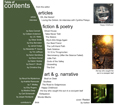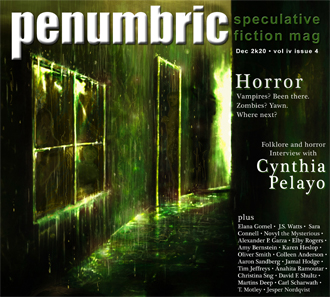From the Editor
by
Jeff Georgeson
previous next


full contents
article
Oh, Horror,
Where Art Thou?
From the Editor
by
Jeff Georgeson
previous

full contents
next

article
Oh, Horror,
Where Art Thou?
From the Editor
by
Jeff Georgeson
previous next


full contents
article:
Oh, Horror,
Where Art Thou?
previous

full contents
next

article
Oh, Horror,
Where Art Thou?
From the Editor by Jeff Georgeson
From the Editor
by Jeff Georgeson
When I was young, I couldn't stand horror. It's not that I thought it was purile (I would have snickered at the naughty-sounding word), or that it was boring, or that it held a frightening mirror up to society (I mean, I was 8 or 10, so ...). It was that I was scared to death of it.
More specifically, I was afraid of the nightmares it would give me. This was especially true of religious horror. We'd had a babysitter ... She was scarcely older than my sister and I, but in youth such differences are a lifetime, and she seemed an adult to us. To me, anyway. We were in a room, in the colors of old-fashioned, of my grandparents' house in the 1970s: browns and golds and sepia tones. I remember it as if it were a dream. My sister played with a toy nearby, something stuffed, something quiet, a bear, perhaps, or a tiny tiger.
I remember the babysitter standing near the doorway, I know not why, but there was no leaving that place. As if I could have gone anywhere, really. She stood, with short, sandy-blonde hair, earnest in what she had to say, filled with all the certainty, all the bombast, all the cajoling and demanding of an expert speaker. Well, expert to an eight-year-old. I stood nearby, near a railing separating the entryway from the living room, made of old, smooth wood, and she stood on the other side, hands sometimes on the rail, sometimes waving in urgency.
There was a god, she told us--nay, a God, a GOD--and HE was our only hope, the only possibility, however slim, of keeping us from an eternity in Hell.
My sister ignored her, still playing. "Rowr," said the tiger. I, however, was rapt.
This GOD, she claimed, was all kind, all compassionate, all powerful, all knowing, but HE would only save you if you repented, prayed, begged to be saved. Heaven was the ultimate reward if he accepted your prayers and praise--but acceptance of these sounded somehow rare, based on doing it the right way and at the right time. And opposite this, your anti-reward if you displeased HIM in ANY way, was the fire and the brimstone and the ever-burning flames of Hell, a land of torture and hate, of pain and ever-lasting death. A darkness that the land of nightmares only touched (and my nightmares were already horrific), and all that if you displeased HIM in any way whatsoever. No questions asked, no quarter given.
There was more, much more, and I will tell it sometime, but not here. But I took this vengeful God to heart, and His Hell, and combined this with my undiagnosed OCD to make my life a maze of rituals, a life of doing everything just the right way, just the right number of times, or else the nightmares would come. And they came regularly.
The last thing I wanted to do was give my imagination more ammunition, and so watching a film like The Exorcist was ... well, even hearing about it, even seeing an ad, might set me off, might send me to my room to curl into a ball and rock back and forth, counting, the numbers trying to supplant the horror of my mind ...
I'm ... better now, if by better you mean fascinated by films showing humans transforming into flesh-eating, flesh-decaying zombies, by monsters and shadows and fear itself. I'm spellbound by interesting portrayals of vampires, by the social implications hidden within the monsters and their victims. I'm even almost able to watch films like The Exorcist, although not without subconsciously mirroring some of the old hand-wringing I did as a child (and I only notice this when my friends point out I'm doing it). The night has become my friend, and the bright bright light of day ... well, not so much.
The psychology of horror has thus become a fascination for me, along with the social implications and other academic-sounding issues. But when I started looking at trends in horror films for this issue of Penumbric, somehow I thought I'd be focusing on genre--slasher vs zombie films, torture porn vs vampires. Nope. A short article turned into a much longer exploration of not only genre but film techniques in horror and, of course, social trends. All of these interact, of course, to create a whole, and so I felt I couldn't ignore any of them, even if that made for another article that skims the surface, that more points the way toward deeper exploration rather than going there itself. Hopefully it's enough to enable you to make deeper explorations of your own.
We follow this with an amazing interview with author and editor Cynthia Pelayo, whose fascination with folklore and horror permeates her stories and books. She's in the midst of several projects, including her novel Children of Chicago, and she talks about this, the expectations of publishers, representation of authors of color, and more.
And then the works within this issue of Penumbric ... they aren't necessarily your typical horror. Some, like "Ghost House," "The Sisters," "Little Fish," "10:10 to Throgmorten," and "Unraveling," have their roots in classic horror, but are distinctly new in their presentation of it. Some may not be considered horror at all, but have a sense of "dread," as Pelayo mentions in our interview: You may find that "Our Best Friend" and "Dark Solstice" aren't horror exactly, but do have that sense to them. And then there are those that cross genre: "Tales Never Told," "Wych-Elm Kings Again," and "Gods of the Valley" are dark and fantastic. And some are viscerally horrific, as "The Left-Hand Path" and "Necromancy (After the Séance Failed)," and Christina Sng's excellent textual end to this issue, "The End."
The art is similarly diverse, in palette as well as tone. Happy Childhood evinces some of the horror thematically expressed in some of the textual pieces, while Deliquesce is of a different kind of horror entirely, while Soulless and Skull on Desk aren't specifically horrific, but harken back to that sense of dread, or of things not being quite right. the boy who caught the sun in a cocoyam leaf wouldn't immediately go down that path; it is more fantasy, but I think fits well in this issue, as do our continuing graphic narratives The Road to Golgonooza and Mondo Mecho. And, of course, toeken's cover art Reeled invites us--if we aren't squeamish--down the path into horror's future.
Thank you again to everyone who contributed to this issue, and may the works herein take the edge off the horror of reality for the next couple of months.
Jeff Georgeson
Managing Editor
Penumbric











